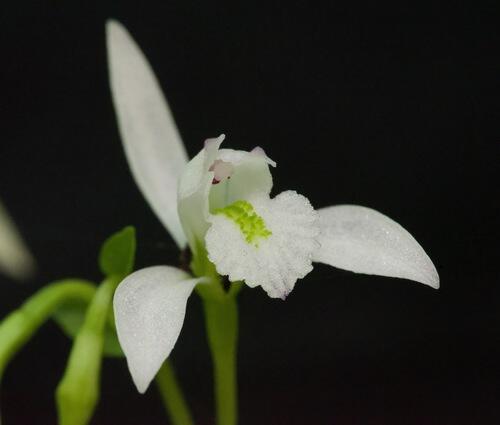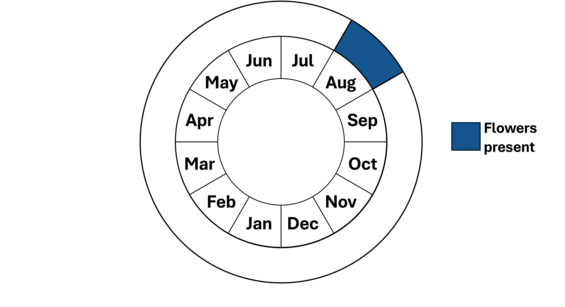- Scientific name: Triphora trianthophoros
- Species of Greatest Conservation Need (MA State Wildlife Action Plan)
- Endangered (MA Endangered Species Act)
Description

Nodding pogonia, or three birds orchid (Triphora trianthophoros), is a delicate perennial of the Orchidaceae family. This small and inconspicuous plant forms colonies by stolons (horizontal, above-ground stems), often hidden in leaf-litter. White to pink flowers open for only one or two days each August and in some years may not emerge from the ground at all. Like many orchids, it is thought to depend upon a symbiotic relationship with soil fungi. In Massachusetts, this tiny plant often grows in shallow depressions of beech-filled woodlands on slopes and in ravines. It is usually associated with beech elsewhere in New England as well.
This plant is most often found in colonies of clustered stems. Each stem usually bears three (sometimes more) white to pink flowers which, at maturity, nod from the axils of leaf-like bracts near the top of the stems, resembling small birds. The labellum (lowest, “lip” petal) of each flower has three green to yellow, raised ridges.
This species is quite distinct from the other orchids of mesic woodland habitats. The combination of its 1) colonial nature, 2) relatively unspecialized labellum which does not form a pouch, sac, or spur as in many orchids, and 3) small, alternate, ovate, clasping leaves serves to distinguish this from other small woodland orchids.
Life cycle and behavior
This is a perennial species.

Population status
The nodding pogonia is listed as endangered by the Commonwealth. It is also considered to be rare throughout the New England region. As with all species listed in Massachusetts, individuals of the species are protected from take (picking, collecting, killing) or sale under the Massachusetts Endangered Species Act. MassWildlife’s Natural Heritage & Endangered Species Program database has 12 records from 3 counties: Berkshire, Franklin, and Hampden. Eight of those records are within the last 25-year period.

Distribution and abundance
This orchid is found from Maine west to Wisconsin and south to Florida and Texas.
Habitat
Nodding pogonia grows in sloping, mesic, mixed hardwood forests, usually beech-dominated, in deep pockets or hollows with accumulated leaf litter and deep humus. It is usually found with very few herbaceous associates. Light is usually filtered through a moderately open canopy. Soil pH does not seem to be an important factor for this species.
Healthy habitats are vital for supporting native wildlife and plants. Explore habitats and learn about conservation and restoration in Massachusetts.
Threats
The upland, wooded habitat of this species is threatened by conversion to residential or other types of development. Ill-timed or heavy timber harvest or removal of leaf litter would also be detrimental to the nodding pogonia.
Conservation
Little is known about the specific requirements of this small orchid; however, relationships with soil fungi within the woodland community are thought to be important. As such, maintaining the intact surrounding habitat with as little human disturbance as possible is the primary management goal. Because orchid propagation and reintroductions are notoriously difficult, reintroduction may not be feasible, at least until extensive research is conducted to elucidate the complex relationships this plant may have with soil organisms, pollinators, and other plants.
Contact
| Date published: | May 7, 2025 |
|---|